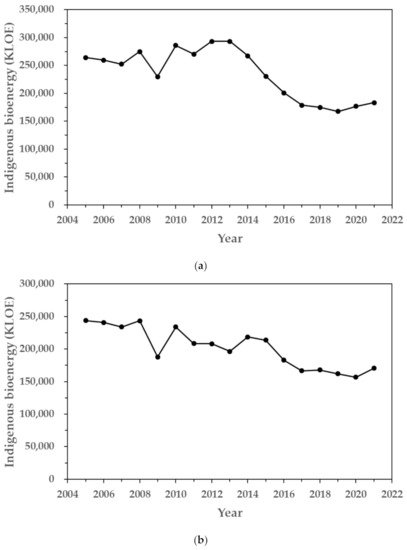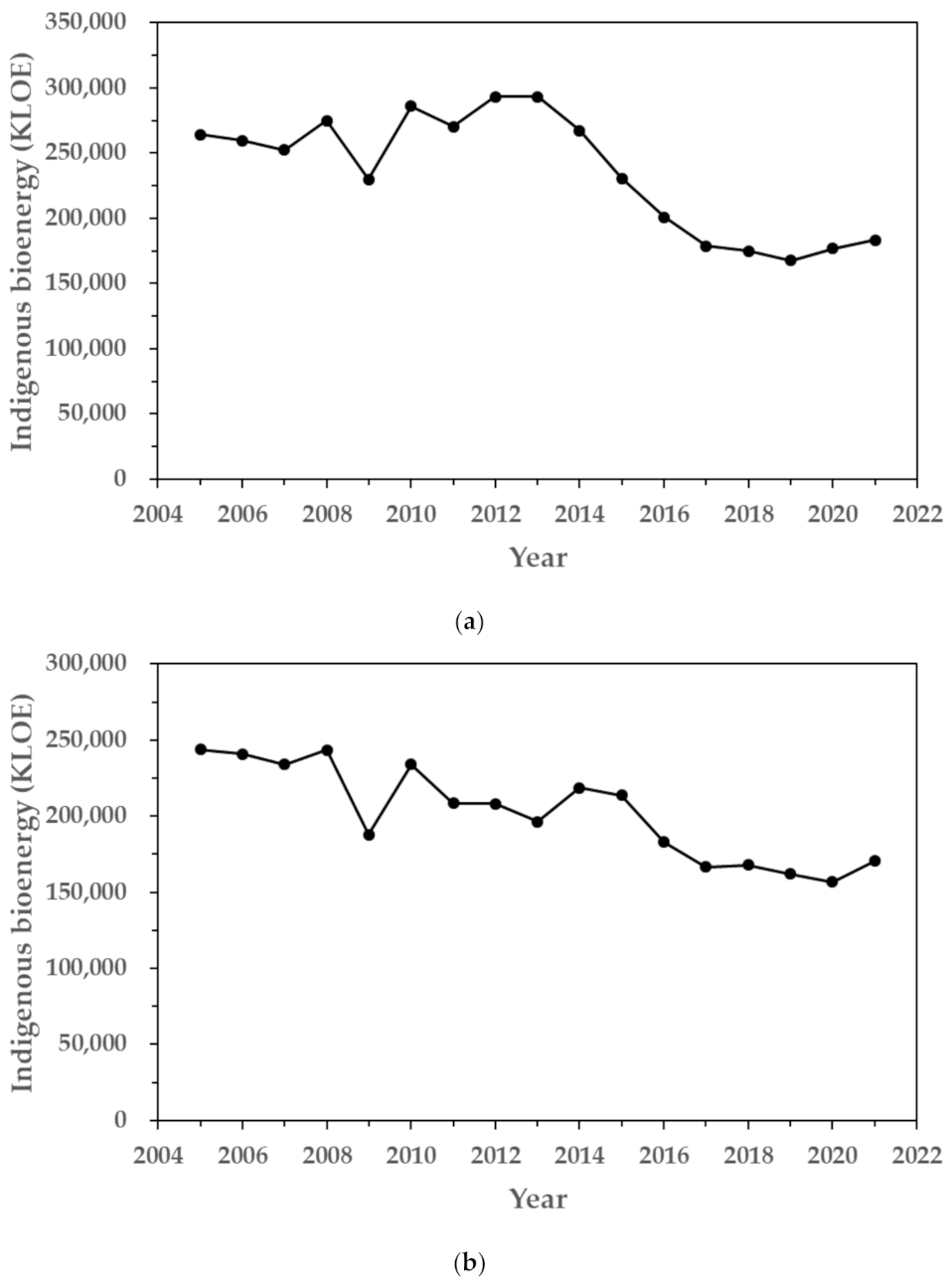In order to reduce the emissions of carbon dioxide (CO2) from existing fossil fuel plants, biomass or lignocellulose-based waste was used directly as a solid fuel or as a supplement to fossil fuels. Although the traditional combustion of solid-type biomass in open fires or cook stoves could have an impact on human health and the environment, bioenergy for power generation (or electricity) and transport fuels (i.e., bioethanol and biodiesel) has been growing quickly in recent years, mainly because of the policy support and regulatory compliance. In order to reduce the dependence on imported energy supply as well as to mitigate GHGgreenhouse gas (GHG) emissions, the Taiwanese government has been actively promoting renewable energy development to increase the indigenous energy supply for electricity and heat generation in the energy and industrial sectors.
1. Status of Agricultural Waste Generation
In general, the agricultural sector comprises establishments primarily engaged in growing crops/fruits/vegetables/flowers, raising animals, logging wood, and harvesting fish and other animals from a farm, ranch, or their natural habitats. Agricultural waste can be defined as unwanted waste or residue produced from agricultural activities.
Table 1 summarizes the statistics of biological waste generation from the agricultural sector since 2010
[8][1], grouped into five categories. The significant notes are summarized below:
Table 1.
Statistics of biological waste generation from the agricultural sector in Taiwan
a
.
13][5], biomass energy or bioenergy refers to energy generated from the direct use or treatment of vegetation, biogas, and domestic organic waste. Lignocellulosic biomass like wood may be the largest biomass energy source. Other sources included crop residues, grassy and woody plants, residues from agricultural production (products derived from forestry, aquaculture, and livestock/poultry), oil-rich algae, spent cooking oil, kitchen waste, and the organic components of non-hazardous industrial waste such as sugarcane bagasse and pulp black liquor
[15][6]. These resources can be used to produce a variety of energy forms, including biofuels (e.g., biodiesel and bioethanol), heat (or stream), and electricity.
Table 2 lists the statistics of imported biomass-based fuels in Taiwan since 2005
[7].
Figure 1 depicts the variations in the energy supply from indigenous bioenergy, indigenous solid-type bioenergy, indigenous liquid-type bioenergy, and indigenous gas-type bioenergy, respectively
[7]. Based on the statistical data on biomass-to-energy in
Table 2 and
Figure 21, some noticeable points are further summarized as follows:
Figure 21. Variations in energy supply from (
a) indigenous bioenergy, (
b) indigenous solid-type bioenergy, (
c) indigenous liquid-type bioenergy, and (
d) indigenous gas-type bioenergy
[7].
Table 2.
Statistics of imported biomass-based fuels in Taiwan
a
.
- -
-
In brief, the agricultural waste generation in Taiwan ranged from 4.5 to 5.2 million metric tons. About 80% of that was from rice-derived residues (rice straw and rice husk) and livestock/poultry-derived waste (manure mainly produced from swine- and cattle-raising). Other significant agriculture-derived residues included spent mushroom compost, oyster shell, and fruit/vegetable residues.
-
- -
-
In order to expand the supply of indigenous biological waste, thinned fruit twigs and bamboo residue were grouped into the statistical items of agriculture-derived waste since 2020. As listed in
Table 1, the amounts of thinned fruit twigs accounted for about 250 thousand metric tons, which were derived from a variety of subtropical/tropical fruits like banana, pineapple, citrus, longan, mango, guava, grape, and lichee
[9][2]. In addition, bamboo residues may include bamboo branches, leaves, shoot apex, joint, skin, sawdust, and shoot shell
[14][3]. According to the Forestry Statistics Yearbook
[10][4], the area of bamboo forest amounted to about 191.6 thousand hectares, representing Taiwan’s rich bamboo resources.
-
- -
-
Regarding the fishery-derived waste, it should include various scraps (e.g., head, tail, shell, internal organs, scale, leather, fin, and bone) after processing or eating fishes, shellfishes, and other aquaculture animals. In Taiwan, the C
ouncil of Agriculture (COA
) only provided the statistics of oyster shell in the fishery-derived waste, indicating a declining trend from 226 thousand metric tons in 2005 to 99 thousand metric tons in 2021. Because of its chemical composition (i.e., CaCO
3), this biological waste is not relevant to energy use.
-
2. Status of Biomass-to-Energy
According to the definition by the Renewable Energy Development Act (REDA) in Taiwan [
- -
-
As seen in
Figure 21a, although the energy supply from indigenous biomass or bioenergy indicated a slight increase since 2019, the reduction from the highest value (293,275 KLOE) in 2013 has exceeded 37.4% in comparison with the value in 2021 (i.e., 183,508 KLOE). Obviously, indigenous bioenergy was mostly from indigenous solid biomass resources (
Figure 21b), including waste wood and sugarcane bagasse. These solid-type biofuels were generally reused as auxiliary fuels in industrial boilers and heaters.
-
- -
-
As listed in
Table 2, the imported energy from biomass has been supplied since the late 2010s, which mainly referred to the imported palm kernel shell for stream generation in the industrial use
[16][8]. Because of the high price of palm kernel shell imported from Southeastern Asian countries in recent years, the imported energy supply has significantly decreased from about 9000 KLOE in 2018 (the highest) to close to zero in 2021.
-
- -
-
In Taiwan, waste cooking oil (WCO) has been reused as a feedstock for biodiesel production since 2006. Under the policy promotion, the supply amounts of biodiesel indicated a soaring growth from 1029 kiloliters in 2006 to 96,373 kiloliters in 2013
[7]. However, the users have complained about some issues, including fuel tank and filter clogging/plugging, ignition delay, and exhaust emissions at higher levels. The Taiwanese government thus temporarily terminated the biodiesel blends (B2) promotion policy in May 2014. Since then, the B2 supply and consumption showed a rapid decline, as shown in
Figure 21c. In order to continuously support WCO recycling in Taiwan, the vast majority of biodiesel by domestic production was exported to European (e.g., Spain) and Asian countries (e.g., South Korea).
-
- -
-
The policy for promoting the use of bioethanol and its domestic production plan started from 2007
[17][9]. Since then, limited gas stations in the metropolitan cities (i.e., 8 gas stations in Taiwan city and 6 gas stations in Kaohsiung city) provided E3 gasohol for all vehicles by subsidizing a discount rate at NT $1.0–2.0 per liter. However, the bioethanol in the E3 gasohol was completely imported because the commercial establishment of a new bioethanol plant in Taiwan was not profitable from the feasibility study. As listed in
Table 2, the supply amounts of bioethanol indicated a decreasing trend, which could be attributed to the inconvenient refueling and insufficient incentives
[17][9]. In the future, the bioethanol must be domestically produced from non-food lignocellulosic resources like crop residues (e.g., rice straw), kitchen waste (food waste), and wood chips.
-
- -
-
The variation in energy supply from indigenous gas-type bioenergy indicated a fluctuating pattern (
Figure 21d). During the period of 2005–2014, it can be seen that the energy supply from biogas-to-power decreased mainly as a result of the depletion of landfill gas from sanitary landfill plants in Taiwan. However, the E
nvironmental P
Arotection Administration (EPA) and COA have jointly managed the applications of livestock (pig and cattle) farms for producing digestate and biogas-to-power from the anaerobic digestion (AD) process since 2015. Since then, it showed an upward trend in bioenergy by biogas-to-power.
-




